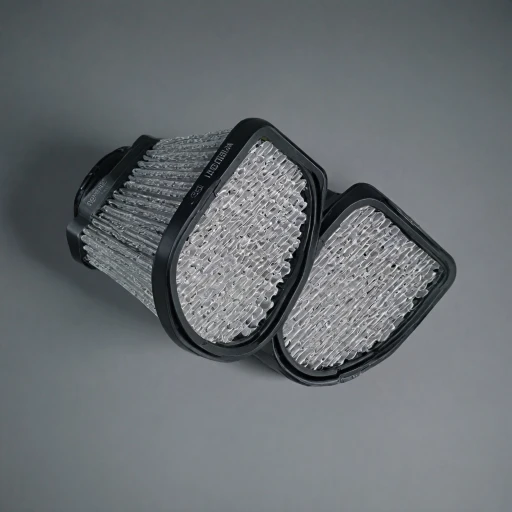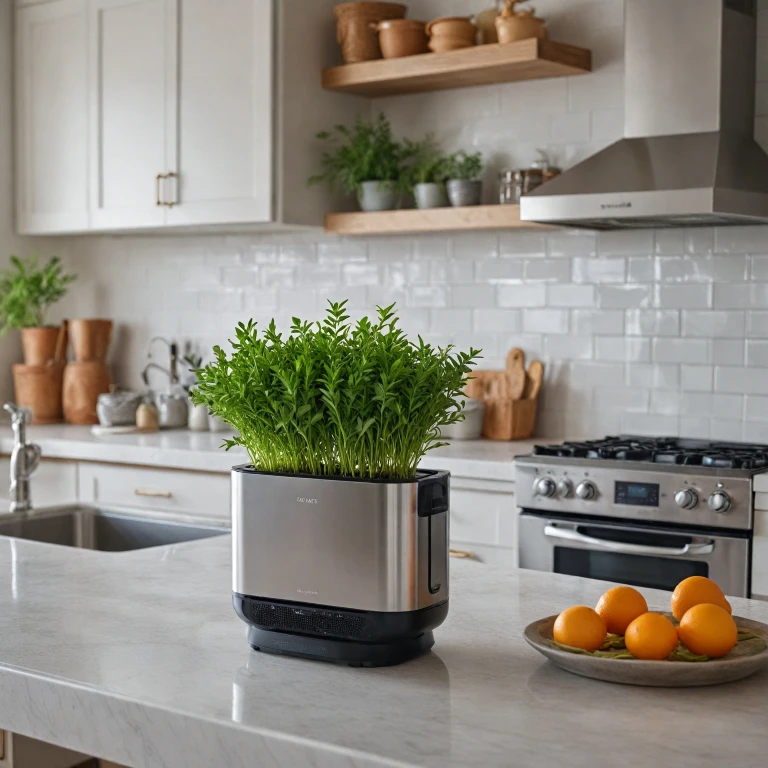Understanding Cooking Odors and Their Impact
Impact of Cooking Odors on Indoor Air Quality
Cooking is a daily necessity for many, but the resulting odors can linger and subtly impact your home's air quality. These odors are not just limited to the immediate smells, but can include a mixture of smoke, oil, and other particles that permeate the air. High levels of these airborne particles, if not addressed, can lead to an accumulation of strong, unwanted smells that are difficult to disperse.
Cooking odors can consist of a range of molecules and particles, from visible smoke to invisible gases and oils. For example, when frying foods or cooking with spices, a complex mix of smoke and odor particles is released into your indoor environment. Over time, this can not only lead to an uncomfortable living space but may also degrade the quality of your indoor air, affecting overall health and comfort.
The role of a reliable air purifier becomes crucial in maintaining a fresh and healthy kitchen air environment. Most air purifiers use a combination of technologies, including HEPA filters and activated carbon filters, to capture and neutralize these cooking odors effectively. Finding the best air purifiers for your needs involves considering factors such as the type of filtration, noise level, room size, and additional features like auto mode and quality sensors.
To effectively handle these lingering smells, it's important to explore air purifiers specifically designed to target and eliminate cooking odors. These devices often feature HEPA filters that trap airborne particles and activated carbon filters that specifically absorb gaseous odors. Regular maintenance, like cleaning pre filters and replacing filters when necessary, will also ensure optimal performance of your air purifier.
For those searching for a more comprehensive solution to improve indoor air quality, understanding the difference between air purifiers and other devices like dehumidifiers can be beneficial. This distinction helps in determining the necessary equipment for your specific air quality concerns. If you're curious about this comparison, visiting this
resource link could offer valuable insights.
Key Features to Look for in an Air Purifier
Essential Attributes for Combatting Kitchen Smells
When it comes to selecting an air purifier to tackle cooking odors, understanding the product's features can make a significant difference. Here's a look at what to consider:
- Filtration System: The best air purifiers for kitchen use typically employ a multi-stage filtration system. A pre-filter is effective at capturing larger particles, while the HEPA filter excels at trapping smaller, ultra-fine particles. Look for purifiers that include a true HEPA filter to ensure high filtration efficacy.
- Activated Carbon Filters: To truly eliminate odors, activated carbon filters are pivotal. These filters excel at absorbing volatile organic compounds (VOCs) and reducing stubborn kitchen smells. They are essential for neutralizing odors from smoke, grease, and other cooking-related sources.Consider these when addressing strong odors.
- Air Purifier Coverage and CADR: Consider the size of your kitchen air or the room where cooking primarily occurs. Choose a purifier with a Clean Air Delivery Rate (CADR) that matches the space to maintain good air quality.
- Noise Level: Since cooking areas are often bustling, selecting purifiers with a lower noise level ensures they won’t disrupt the conversation or ambiance.
- Auto Mode and Quality Sensor: Advanced purifiers often feature auto mode and air quality sensors, enabling the device to adjust its performance based on real-time air conditions, optimizing filtration without constant manual adjustments.
While these features play a critical role, it's equally important to consider the long-term maintenance for sustained efficiency, as explored in upcoming sections.
Top Air Purifiers for Cooking Odors
Leading Choices to Eliminate Cooking Smells
For those battling stubborn cooking odors in your kitchen, selecting a powerful air purifier is essential. Here, we explore a few top air purifiers specifically designed to combat these pesky smells, offering clarity on the best possible options.
- Levoit Core Air Purifier: Renowned for its high-efficiency filtration system, the Levoit Core models are equipped with true HEPA filters and activated carbon filters that substantially reduce smells and improve indoor air quality in the kitchen. The auto mode and quality sensor ensure optimal performance by adjusting to the room’s air quality in real-time.
- Activated Carbon Filter Air Purifiers: This type stands out for incorporating carbon filters specifically designed to absorb volatile cooking particles effectively. They work alongside HEPA filters to tackle both smoke and other fine particles.
- Quiet, High-Efficiency Models: When considering noise level, purifiers engineered for low-decibel functioning while maintaining powerful odor and particle filtration make a great choice. It’s vital for those seeking a peaceful ambiance in their cooking space.
- Multi-Stage Filtration Purifiers: Devices combining pre-filters, HEPA filters, and activated carbon layers not only ensure clean air but also tackle intricate mixes of cooking odors, offering comprehensive air quality control.
Investing in a quality air purifier for your kitchen goes beyond just mitigating cooking odors. It significantly enhances air quality, mitigating long-term exposure to potentially harmful particles and improving overall indoor air experience.
For a broader understanding of optimal air purification technologies, you might find our guide on
exploring the benefits of an air compressor and generator combination insightful. This resource dives deeper into how these elements work collectively for enhanced results.
Comparing Air Purifier Technologies
Examining Filtration Options to Combat Odors
When it comes to effectively managing cooking odors in your home, understanding the technology and filtration used in air purifiers is crucial. The right combination can make a significant difference in improving indoor air quality.
One of the foremost technologies to consider is the HEPA filter. True HEPA filters are known for their ability to capture particles as small as 0.3 microns with high efficiency. This includes small particles that contribute to the lingering smells from cooking. When assessing HEPA filters, ensure you're selecting one that is capable of capturing the majority of particles in your kitchen.
Activated carbon filters are another essential feature when targeting cooking odors. Carbon filters are designed to adsorb gases and volatile organic compounds (VOCs) that are typically associated with cooking smells. Opt for air purifiers with a substantial amount of activated carbon to maximize odor reduction.
Smart Technologies and Additional Features
Many modern air purifiers are equipped with smart features such as an auto mode with quality sensors. These sensors can detect changes in air quality and adjust the purifier's performance to eliminate odors more efficiently. Additionally, the Levoit Core series is one example of brands offering these smart technologies.
Consider the noise level of an air purifier as well. While a slightly higher speed might be more effective, you'll want to ensure the sound remains at a comfortable level, particularly for long-term usage in shared spaces like the kitchen.
Ultimately, finding the best air purifiers for your kitchen involves assessing these technologies and how they can integrate into your lifestyle. By understanding the nuances of filters and the added technologies, you can make an informed decision to keep your space smelling fresh and clean.
Maintenance Tips for Optimal Performance
Regular Cleaning and Replacement of Filters
To maintain the best performance of your air purifier and ensure it effectively deals with cooking odors, regular cleaning and timely replacement of filters are crucial. The primary components to focus on include the true HEPA filter, activated carbon filter, and pre-filters. Dust and other particles can accumulate, affecting the filtration capacity. Be sure to check the manufacturer's guidelines for the recommended frequency of replacement and cleaning process.
Utilize Auto Mode and Quality Sensors
Many modern air purifiers come equipped with an auto mode feature and quality sensors. These attributes allow the device to adjust its functionality based on the air quality in the room. Utilizing these can ensure your kitchen air remains clean and odors are swiftly addressed, as the air purifier will be more efficient in responding to higher concentration of odors or smoke.
Regularly Check for Obstructions
Ensure that the air purifier is placed in a location where the intake and outflow of air are not obstructed by walls, furniture, or other objects. Airflow is essential for optimal filtration and performance. In a busy kitchen, it's easy for an air purifier to become obstructed, reducing its capacity to deal with cooking smells effectively.
Monitor Noise Level
A high noise level can indicate that your air purifier is working harder than it should, perhaps due to clogged filters or obstructions. Regularly monitoring noise levels can help in identifying when maintenance might be needed, maintaining an efficient operation to handle indoor air purification.
Track Long-term Performance
Keeping track of your air purifier’s performance over time helps to assess whether the current settings or filters are effectively managing kitchen odors. If you notice diminished air quality or lingering cooking odors, you may need to consider a higher capacity unit or additional purifiers to enhance your air quality setup.
Applying these maintenance tips will help ensure your air purifier continues to operate at its best, contributing to cleaner and fresher indoor air by effectively tackling cooking odors.
Additional Tips for Reducing Cooking Odors
Strategies Beyond Air Purifiers
When it comes to tackling cooking odors, air purifiers are an effective solution, especially those equipped with features such as activated carbon filters, true HEPA filters, and quality sensors. However, there are additional measures you can take to further reduce these smells and improve indoor air quality.
- Ensure Proper Ventilation: One basic yet highly effective strategy is to improve kitchen ventilation. Utilize range hoods or exhaust fans to quickly disperse cooking smoke and odors out of the room. Opening windows to allow fresh air to circulate can also dilute and remove odors naturally.
- Regular Cleaning: Frequently cleaning kitchen surfaces, including stove tops and counters, removes residue that might emit lingering odors. Don’t forget to clean sponges, dish cloths, and garbage areas regularly.
- Cook with a Lid: Whenever possible, cover pots and pans with a lid while cooking. This can help minimize the dispersal of strong cooking smells into the air.
- Use Natural Deodorizers: Utilize natural odor absorbers like vinegar, baking soda, or lemon. These agents can neutralize unwanted smells in the kitchen when left out in open containers.
- Limit Smoke Production: Adjusting cooking temperatures to avoid burning oils and food can reduce the production of smoke, which contributes to the spread of strong odors.
Integrating these habits into your daily routine will complement the benefits offered by your chosen air purifier. As you continue to enjoy clean air, remember that maintenance and the right purification technology are key for long-term high quality air. Keeping your air purifier in auto mode can also assist in maintaining optimal performance by adjusting settings based on current air conditions. By combining the best strategies, you can maintain a more pleasant and welcoming kitchen atmosphere.

